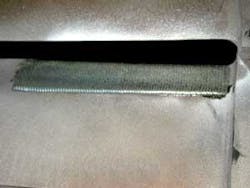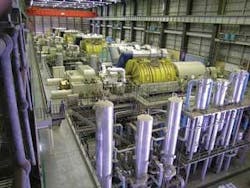Laser technology repairs low-pressure turbine blades on site
Milan Brandt
A technique for repairing, in situ, the worn and eroded leading edges of low pressure (LP) turbine blades using a high-power diode laser and optical fibers has been developed by the Industrial Research Institute Swinburne (IRIS), Swinburne University of Technology (Melbourne, Australia), under a project funded by the CRC for welded structures and a consortium of power utilities. The service life of electrical power station LP steam turbine blades, which suffer from severe operational erosion, is of huge importance to a power generation plant. Using this new technique, estimates are that a power station can save some $10 million in downtime expenses over the life of the power station.
Laser repaired leading edge.
Replacement of high twist blades is very expensive, and therefore emphasis is placed on techniques for extending the safe life of these blades. This is achieved by the use of leading edge protection strips that are brazed onto the forged blades. Traditionally this maintenance operation requires the blades to be dismantled from the rotor and new shields installed, resulting in a long downtime period for the generator and, subsequently, significant cost. This new development allows these protective refractory alloy shields, usually made from cobalt/chrome alloys, to be manufactured onto the blades in situ using the high-power fiberoptically delivered laser with the application of the alloy as a powder.
The beam from a Laserline high-power diode laser delivered to the surface via an optical fiber melts the powder and fuses it to the blade producing a thick erosion-resistant coating over the required blade area. The specially developed powder delivery nozzle and laser delivery optic are mounted on a robot arm that follows the shape of the blade to produce the coating over the required blade area. This technique was recently tested at TXU Torrens Island Power, in Adelaide, which involved bringing the diode laser, robot, and alloy powder delivery system from IRIS and repairing a number of LP blades on the rotor.
This technology offers tremendous potential for the in-situ repair of components that are difficult to take out of service. This has only been possible in the last few years due to the development of relatively compact, transportable, powerful, and highly efficient laser sources. Additionally, this work has convincingly demonstrated the value of a true collaboration in which the combined expertise from research institutions, CRC, and industry sponsors were brought together to develop and implement this innovative new technology. The field trial is regarded as successful and new applications are being investigated.
This research is part of IRIS’s strategy to be the leading research provider of manufacturing solutions to industry with an extraordinarily successful platform of applied research and technology.
Professor Milan Brandt, [email protected], leads the IRIS team that developed the technology for in-situ repair of components.

